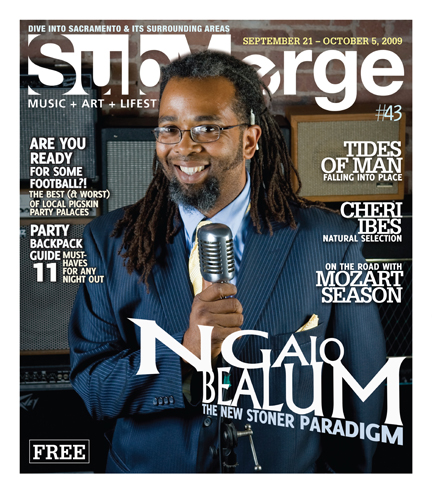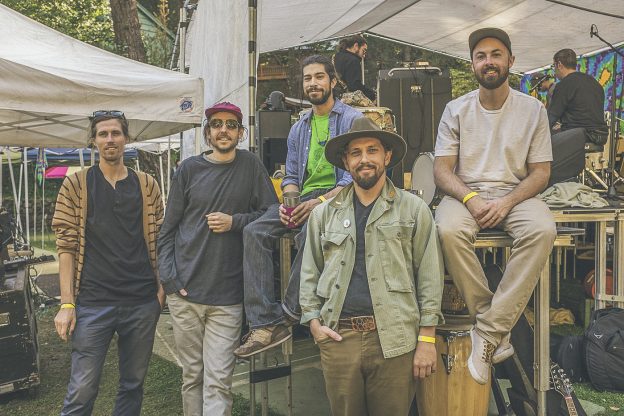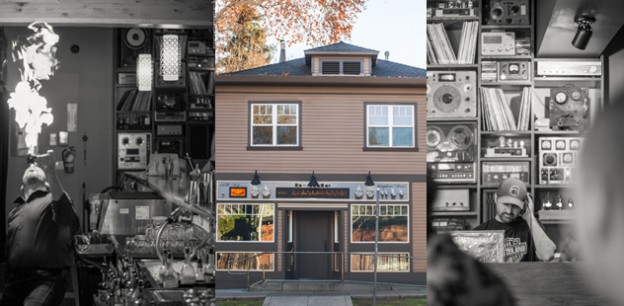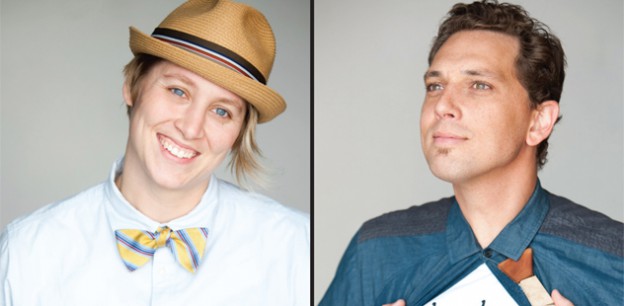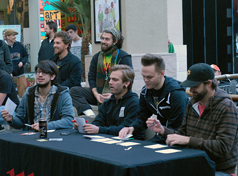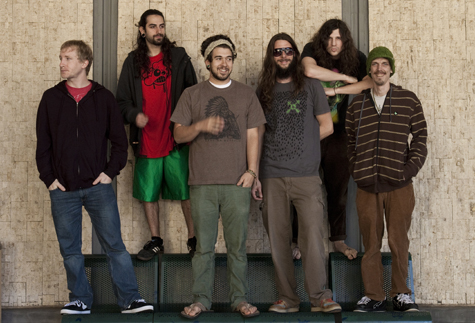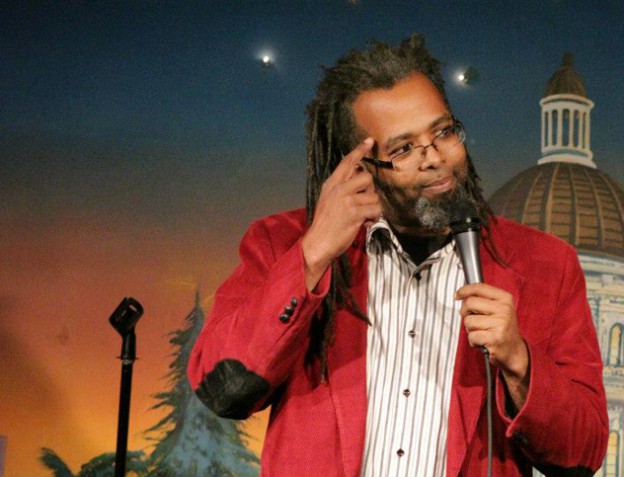We all need that extra push at times. Every person on this planet knows what it’s like to need encouragement to put themselves out there. That’s what Rik Krull, lead vocalist and guitarist for local indie-folk band Güero needed to put his music out into the world. If it wasn’t for friend and eventual bandmate Wes Davis giving Krull the push he needed, Güero wouldn’t exist.
“It took a while to get Rik interested in playing out,” said Davis. “It’s like, ‘Let’s take this out somewhere!’”
The friends and then roommates decided to play some open mics around the city and the band finally got started in the early 2010s.
Since Davis gave Krull that initial nudge, Güero has grown into a five-piece, and the band’s music has carved out a unique niche for itself.
Today, Krull and Davis are joined by Mike Ruiz on drums, Russell Volksen on bass and Shea Ritchie on keyboard. They are set to release their self-titled debut album and are celebrating its release Oct. 13, 2018, at Old Ironsides. It took some time for the music that appears on that record to be ready for wide release. The band had to go through a few changes that were nearly a decade in the making.
“Before [Ruiz, Ritchie and I joined Güero], it was Wes and Rik. It was different,” said Volksen about the original iteration of the band. “It was just acoustic and banjo. It had a totally different feel. You bring in bass and drums and it kind of gives it more of a pulse.”
Volksen was the first to join Davis and Krull after Davis kept insisting that Volksen needed to come play bass with them. Then came Ruiz because the three were interested to see what the songs would sound like with drums, and he became vital to the project. Ritchie joined after the four asked him to help with recording their music. He hopped on keys and has been with Güero ever since.
That different feel Volksen mentioned comes from the evolution of these songs. Before the band started, Krull had written a huge amount of songs that were never intended to be heard by anyone else.
“When we lived together, [Krull] brought out this archive of songs that he had written that hadn’t seen the light of day,” said Davis.
The guys in Güero say that Krull has even more—“a book full”—of songs that no one has ever heard. It’s easy to assume that some of the band’s debut is made up of those old songs that Krull has been keeping in his back pocket for years; but according to Volksen, the band is always working on new music. And sometimes, the lyrics are sung in Spanish.
“[Krull] has his degree from UC Davis in Spanish,” reported Davis. “He’s spent many a summer in Barcelona. That’s where the name Güero came from because his nickname was always Güero.”
The term güero is slang used in Mexico used to describe someone who is Mexican and has pale skin.
The song “Camino,” which appears on the album, is a six-minute tale about a Greyhound bus trip Krull once took from Northern Mexico back home to Sacramento. If the song’s description on Bandcamp can be trusted, Krull met a man named Red who used a vacuum to suck the change out of vending machines.
If you aren’t Spanish bilingual, and don’t understand all the lyrics from the band’s Spanish tracks, don’t worry; neither do Krull’s bandmates.
“We understand the meanings of the songs and some of the words,” said Davis.
“It’s funny, [Krull] used to [sing in Spanish] a little more because it’s easier to rhyme because a lot of the words end in a similar way,” said Volksen. “There are a couple of lines in that song that I don’t know what they mean, and I’ve been meaning to ask him. It’s been years now!”
The 11-minute epic “Stamp” is a definite highlight of what the band has released thus far. It’s a lush, vibrant composition and comes with more structure than is typical of the standard jam-band fare. It begs the question of where Güero lies in terms of genre.
Their Bandcamp page tags them as “baroque pop” and “synthpop,” while their Facebook will have you believe that the band plays “indie skate rock,” a term Davis and Volksen are pretty sure Submerge coined in a previous issue. None of that is enough to describe the scope of what Güero is employing in their songs.
Davis plays the banjo and the charango, but they aren’t playing bluegrass or traditional Colombian music. Volksen, like many musicians, played jazz band in high school, but that’s not the only influence on his playing. Krull’s voice has been said to be reminiscent of both Jeremy Enigk of Sunny Day Real Estate and Colin Meloy of the Decemberists.
That’s the thing about Güero; all those influences are evident in what the band creates because every member believes in experimentation and taking their own path. That alone, however, isn’t what defines the music. It has its allegiances in terms of sound and genre, but Krull and company made this music because it means something to them. Davis and Volksen would say that much of the focus for their music is on Krull’s voice.
“[Krull] just has a really unique voice and he has a really good ear for cadence,” said Davis. “He’s just naturally gifted.”
“He’s got such a great voice,” continued Volksen. “It’s pretty mind-blowing if you don’t know what you’re expecting. It’s like, ‘Damn, this guy can really sing!’”
Despite that bravado, Güero is a band full of modest members. The songs may start in Krull’s notebook, but the end result is a group effort.
“[Ritchie] is the most gung-ho out of all of us,” said Davis.
“[Ritchie] just wants to give it his all,” said Volksen.
“It’s funny because we have opposite ends of the spectrum,” continued Davis. “[Krull] is not on social media at all. He’s got, like, zero ego. He’s not trying to self-promote. I have to go over to his work to tell all his colleagues about our shows because he’s not telling them. On the opposite side, you’ve got [Ritchie] who’s trying to do all the promotion and the rest of us fall into the middle somewhere.”
It’s a balance that has become integral to the band. That balance and love can be heard in their tracks.
Like the band wrote on their Facebook page, “doesn’t matter where or when; garage or venue …as long as we are together we will continue to do what we love.”
Catch Güero live at Old Ironsides (1901 10th St., Sacramento) Saturday, Oct. 13 to celebrate the release of their self-titled debut CD! Also performing is Dylan Crawford, and André Fylling. Show starts at 9 p.m. $7 at the door and CDs are $8. Güero also hits the stage on Saturday, Oct. 20 at Bar 101 (101 Main St., Roseville) for free! 9:30 p.m. start time. Check out Facebook.com/guerotheband for more info.
**This piece first appeared in print on pages 12 – 13 of issue #275 (Sept. 26 – Oct. 10, 2018)**
Get the Spins
As my friends know all too well, when I drink, I like to DJ. So when I heard about a new dive bar in Midtown called B-Side, where you could play your own records, I wondered why I hadn’t thought of this brilliant concept myself.
B-Side is operated by the time-tested trio that brought Shady Lady to the forefront of Sacramento cocktail culture. But unlike Shady Lady, B-Side has a laid-back dive-y atmosphere. There’s no velvet damask wallpaper and moody lighting; there aren’t even drink menus. It’s the kind of place where you’re not going to be out of place in a hoodie and can get anything from a $3 Oly on tap to a fancy you-call-it cocktail with its corresponding high price tag.
“As much as we all love cocktails, there’s something to be said for a simple bar with no frills,” says Garrett Van Vleck, one of the managing partners at B-Side. “People seem a little surprised when we tell them there’s no cocktail list but they also quickly realize how nice it is to order whatever they want. We wanted a back-to-basics dive bar, but if you order something like an Old Fashioned or a Manhattan, you’re going to get the same quality drink you would at Shady Lady.”
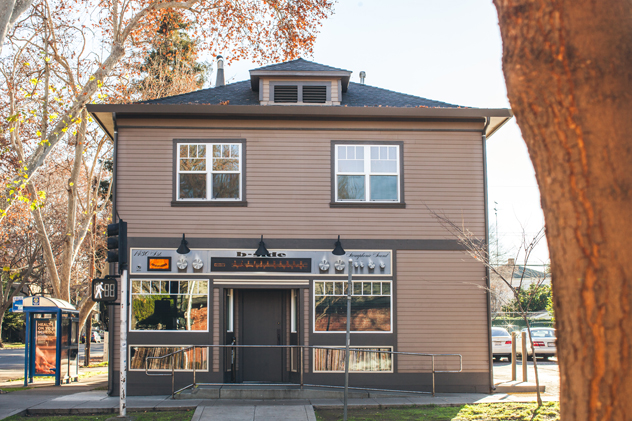
While Shady Lady’s decor is decidedly prohibition-era themed, B-Side has a sleazy ‘70s audiophile vibe. Rope lighting lined the bar shelves with record sleeves serving as the sole non-alcohol bar adornment. A collection of antique audio equipment backed the prominent DJ booth while a Russ Meyer film played scenes of gratuitous nudity of mod babes with blue eyeshadow and big hair. Between the patrons and DJ Roger Carpio spinning an eclectic mix of vinyl, it was very loud.
“We started with the idea of doing a vinyl record-centric concept and the ‘70s vibe sort of developed as an extension of that,” explains Van Vleck of the inspiration for the bar concept.
Sacramento DJ veteran Shaun Slaughter heads up the event booking at B-Side. During one of the regular events, “Loose Change,” the DJs pass out request books and people can pick from a selection of 45s. At another event, Vixens of Vinyl, female DJs headed up by DJ TrashEpiphany spin psychedelic, garage, punk, glam and trash. Open turntable night encourages anyone to bring a couple of their favorite records and take turns DJing.
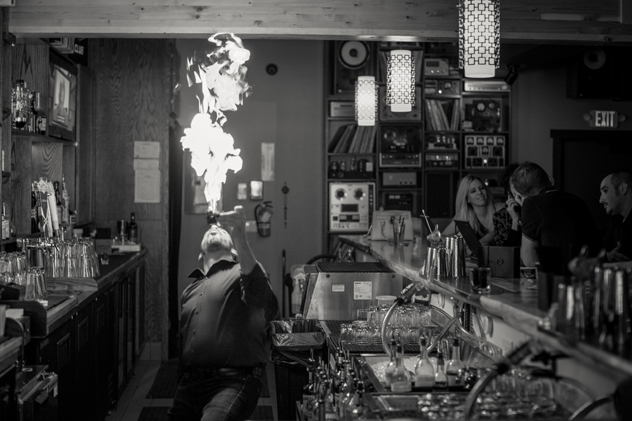
Slaughter enthusiastically describes his approach to B-Side’s entertainment.
“My idea is that all the DJs should make it feel like a house party,” says Slaughter. “Each night has its own theme, but the only instruction I gave them was to have fun and don’t think about it too much … Originally I thought about booking only ‘70s-sounding stuff to align with the bar concept, but Garrett really emphasized doing all kinds of music. We’ve been having a blast!”
Bret Bair, known locally for his ownership of Ace of Spades and part ownership of Goldfield, also owns the building in which B-Side resides, along with its liquor license. The building formerly housed the defunct, but legendary, Monte Carlo.
Van Vleck explains how the Shady Lady gents (which includes Jason Boggs and Alex Origoni) came to lease the B-Side space.
“Bret Bair from Ace of Spades bought the building a couple of years ago and kept it running for a little while as the Monte Carlo,” says Van Vleck. “Then he shut it down and started doing some rehab on the building. About a year ago we reached out and inquired about teaming up to do a project. We all felt like the B-Side concept was a good fit for the space and moved forward from there.”
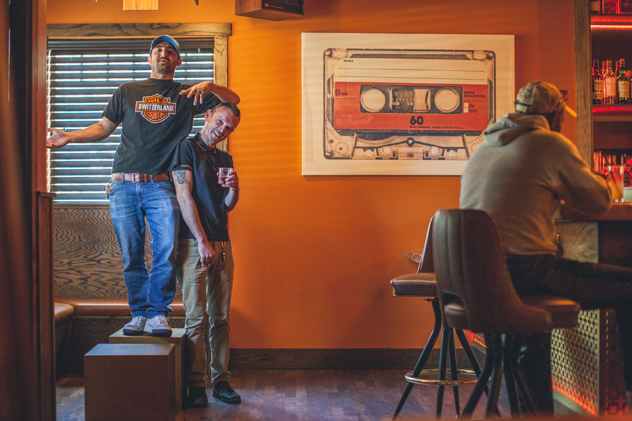
{Alex Origoni and Jason Boggs}
Origoni, Boggs and Van Vleck have their hands in many regional projects, including Brewster’s in Galt, Fieldhouse in the Arden area and upcoming establishments Amaro (an Italian bistro slated to open in the R Street Corridor and partly owned by Deftones’ Abe Cunningham) and Sail Inn, which will revamp an existing bar on the West Sacramento riverfront.
One would think that working so closely together on so many diverse projects would wear on their friendship, but Van Vleck divulges that they get along better as time goes by.
“The three of us have polar opposite personalities and that works to our advantage,” says Van Vleck. “There’s no yes men and you never have to worry about getting an honest opinion. We argue all the time about every detail of every place, but in a constructive way. At the end of the day there are no egos, we just debate the ideas until we settle on the best one, then have a shot of whiskey.”
While good music and libations flow freely at B-Side, one thing you won’t find—yet—is a bite to eat. But times will change.
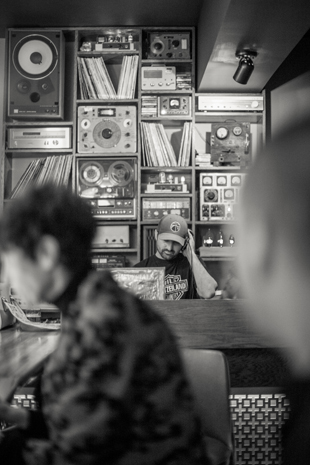
“We are going to add on a patio and do a food truck program as often as possible,” says Van Vleck. “Right now, we’re just concentrating on getting the bar running smoothly, but hopefully the food side will come along soon.”
So far, B-Side seems to be a neighborhood bar in terms of the clientele. And that’s exactly what the partners are going for—although time will tell what kind of crowd will become regulars.
One thing’s for sure: these guys know what they’re doing and have a track record of successful execution of their bar and restaurant concepts. Pair that with a unique idea like B-Side and open up shop in a city full of music junkies, and you’ve got yourself a dive bar that is sure to stick around for a long time. B-Side is solid gold.
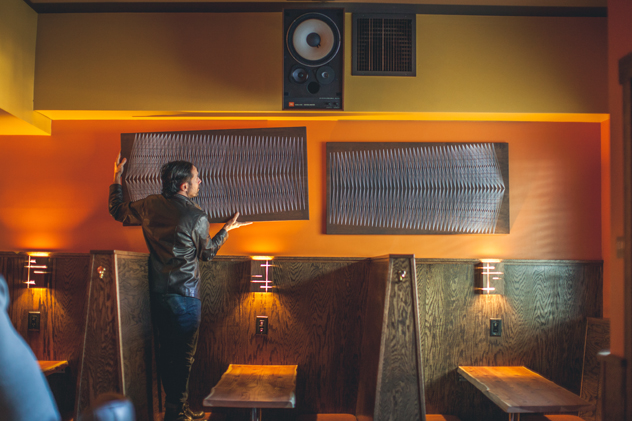
{Local artist Jose Di Gregorio hanging his art work inside B-Side}
B-Side is open at 1430 S Street from 11 a.m. to 2 a.m., seven days a week. Find them on Facebook to view the full events calendar.
For the past six years, Beatnik Studios has played a vital role in Sacramento’s art and music scenes, hosting creative events, throwing rad parties and gallery openings and acting as a crucial link in the arts chain. In August 2013, Beatnik partners Lindsay Calmettes and Wes Davis (both amazing artists/photographers in their own rights and, in full disclosure, Davis has taken many photos for Submerge over the years) took things to the next level by purchasing their own building. The early 1900s “brick and steel battleship” is, according to Beatnik’s press release, “Over 12,000 square-feet of limitless potential.” The building is located at 723 S Street in the Southside neighborhood of downtown Sacramento and was originally built by PG&E. Purchasing and renovating the building was truly a family affair with members of both Lindsay and Wes’ families coming together to assist with the massive amount of work. The Beatniks also found “grease for their wheels” thanks to the PACE (Property Assessed Clean Energy) funding program called YGreen.
“Sacramento YGreen has made it possible for our small business to take on a large-scale commercial renovation project,” they wrote.
The new space allows Beatnik Studios to remain a multi-faceted creative business just like it’s always been: Event space, music venue, art gallery, photography studio, wedding venue—you name it, Beatnik can probably host it. Flexibility is the name of their game. To celebrate their big move and b-day, Beatnik will host a free six-year anniversary and grand re-opening party on Saturday, Aug. 2, 2014, at the new location. The party runs 6 p.m. to midnight and will feature live music by Guero, Jazz Gitan, The Foxtails, Proxy Moon and IdeaTeam as well as a dance performance by Aerial Evolution. There will also be food, drinks, art and all sorts of other rad creative things to enjoy. Learn more at Beatnik-studios.com
Local pro skater and longtime musician Matt Rodriguez has a style all his own
For having had such a long, successful career as a professional skateboarder, going on trips around the world to film countless videos, landing in magazine spreads left and right, co-founding a popular footwear company called iPath, all while earning what many might call “legendary status” along the way, Matt Rodriguez is a really mellow, surprisingly normal guy. In fact, when Submerge arrived at Rodriguez’s Midtown house in early January, we found him in his backyard shoveling dog poop. See, pro skaters are just like you and me.
One major difference between Rodriguez and the rest of us, though, is that the remainder of his yard, the part not covered in dog doo doo, is made up of a custom skate park with ramps built from salvaged wood.
“It was kind of like a scavenger hunt,” Rodriguez said of his lengthy search for re-usable lumber. Although extremely well built, the ramps are steep and gnarly with tight, technical lines; definitely not easy to skate. In a way, that sort of sums up Rodriguez’s style. He’s known for rolling up to spots that to the untrained eye might not even look skateable, but before long he’ll have a couple tricks bagged and will be ready for band practice (he plays drums in local band The Storytellers as well as percussion in a musical experiment called Blktop Project with fellow pro skaters Ray Barbee, Tommy Guerrero and Chuck Treece). A dirty drainage ditch here, a makeshift plywood ramp leaned up against an electrical box there, and Rodriguez can make anything and everything he approaches on his skateboard, no matter how sketchy or unusual of a spot it is, look downright stylish.
Case in point: After an interview sitting with Rodriguez amongst the ramps in his backyard, photographer Wes Davis and Rodriguez set out on one of a couple missions to snap some photos to accompany this article and Submerge decided to tag along. After loading up a couple skateboards and a case of camera equipment into one car, we headed for a bank spot in West Sacramento near Raley Field that Rodriguez wanted to session. “It’s been here for years but was always fenced in, so I couldn’t get to it,” he said of the feature. The fence recently came down so he’s taking full advantage. As we rolled up to the spot, Submerge couldn’t help but notice that the small concrete bank Rodriguez spoke of was literally smack dab in the middle of a dirt field. Not where you would typically think to go to snap a photo of a skater, like, say, somewhere with more concrete.
“This is the story of my career, fucked up spots,” Rodriguez joked.
We arranged three or four long, narrow pieces of wood as his run-up to the bank to gain speed. He’d start in the dirt with his board in hand and would sprint toward the makeshift ramp, hop on his board and then pop a trick on the lip of the bank. Davis lined up the shot from a number of angles, at times getting down and dirty laying flat on the ground to get the proper vantage point.
“Sometimes you’ll be at a spot for hours trying to get a shot,” Davis said of the tedious art that is photographing skating.
Lucky for us, Rodriguez was on this particular day and half-an-hour or so later we had a few keeper shots, some of which show the Tower Bridge directly behind Rodriguez mid-trick. We’d captured two Sacramento icons in one shot, a success indeed.
After the dirt field bank spot, we headed around the corner to an entrance near the ballpark and immediately started, pulling pieces of plywood off of nearby lumber piles, building a makeshift launch ramp and a landing with a tall obstacle in the middle for Rodriguez to olly over. You know, another typical Rodriguez style set-up consisting of randomly found wood and obstacles. Just as we were about done with the set-up and Rodriguez was getting ready to hit it, we heard someone yell at the top of their lungs, “Hey!” and we saw what looked to be like a security guard pointing at us from a distance. We thought nothing of it until we saw him start running, so we scurried back to our car and hopped in before he could give us any shit. Crisis avoided.
“Just like the old days,” Rodriguez said, smiling ear to ear as we sped off, tires chirping.
On the car ride back to his house, Rodriguez spoke of wanting to get into photography, stating that it would be a good way to keep involved in the sport as he gets older. At 35, Rodriguez is surely no young buck, but one look at his part in the recently released iPath team video The Other Ones shows he’s still at the top of his game and likely will not be dropping off the radar anytime soon. “Trust me, I’ve been a part of a lot of videos,” Rodriguez said. “Some I’m proud of and some I’m not so proud of. This one, as a team we did some missions and covered some ground and gathered some good footage. It is what it is, I think it’s good, honest skateboarding.”
In the following interview with Rodriguez, you’ll learn more about iPath and his involvement in the company, his passion for music and how it ties into his skating, his love for Sacramento and tips for growing dreadlocks. Pick up The Other Ones at local skate shops or find it online by searching “iPath The Other Ones.”

What have you been up to lately? What have you been focusing your energy on?
Skate-wise, doing a lot with iPath right now, designing some shoes and trying to scout out some possible new members for the team. We just finished a video, The Other Ones, so just doing that, keeping that fire burning. And you know, music, The Storytellers and Blktop Project. We just did a Blktop tour in Japan.
How was that?
It was awesome, we went for eight days. It was great.
You were one of the original founders of iPath back in the late ‘90s. Since then the company has gone through a couple of ownership changes and it seems like it’s been on a bit of a roller coaster. What is your role at the company now?
Just someone who they, at least the new owners, look at as a headstone basically. Being there from the dirt up, going through all the metamorphosing, to team changes and new owners. Now it’s on its third owner, and hopefully its last. Just being someone who they look to for direction, being a skater, you know, they figure, “This guy knows what he’s doing and has been here from day one.”
I’ve read that Klone Lab, the new owners, want to get the company back to its roots. It’s got to feel good knowing that everyone is on the same page when it comes to realigning the company with it’s original values and image, right?
Yeah, whereas a lot of stuff changed when Timberland bought it. They hired a general manager, he came in and just cut half the team, and the half of the team that he cut were big personalities and a big part of the company, that makes up the vibe. A lot of stuff went through change then. But Timberland came into the situation not knowing who the hell was who in skateboarding. Through the time they had it, it grew and maxed out every year and was showing increasing growth, but I just think it wasn’t enough for them and they had other stuff on their plate. They actually sold Timberland, so the good thing is that they put iPath on the market for someone to take instead of canning it. They could have been like, “We’re over it, sorry.” But they realized that it’s a collective of skaters and artists, and a lifestyle even beyond just skateboarding, and they respected that and they wanted to give it a chance for someone else to take the time and energy. So Klone Lab stepped in.
It’s a tough market out there for small shoe companies, isn’t it?
Oh yeah, you’ve got companies like Nike, even all their pros that they pay to skate for their team combined is still barely a chunk of what they pay Tiger Woods. So skating for Nike, it’s fun, they can have fun with it, but it’s not their livelihood. With something like iPath, from the original investors to the investors now, that’s all they have, they have to make it work. But, you know, we’re just wanting to take more road trips, trying to get articles, making some films, get it all out there and just keep it going. Just keep trying to show the raw side and the soul side of skating.
As a company, especially coming from a grassroots budget, let alone motive, it’s not always easy. We don’t have X amount of dollars to just blow and have fun with, we have to make every dollar count. Granted, not everything runs smooth, even when you have all the dollars to wipe your ass or sweaty forehead with. But nonetheless it’s all about keeping going, nothing is going to be perfect. It’s like a band, sometimes a member gets fed up and can’t take it, or you want to bring a new member in, or someone wants to go in a different direction, or there’s a falling out. Whatever you have left, you have to work with.

The iPath skate team has gone through changes recently and a lot of people were dropped, right? Who is officially on the team now? I read somewhere it is just you, Fred Gall, Kenny Reed and Steve Nesser. Is that true?
Yeah, for right now.
About The Other Ones, there’s a long story behind why it didn’t get “officially” released through iPath, can you touch on that please?
It’s an independent effort from the team, because at the time iPath knew people were going to have to be cut, and they didn’t want to put it out as “the iPath video” and then a month later, half the team is gone. So for now, for our individual talent and credibility, the video is out. It’s out there as opposed to out of sight, out of mind. The team got together and were like, “Fuck it.” iPath still put in some money to produce it, most of the footage in that video is from iPath tours, so iPath is still a big part of it.
The song during your part, you recorded that right?
Yeah that was me and Tommy [Guerrero], that was just on the cuff. I was like, “Yo I want to come down and throw down a rhythm.” We set up the mics and just fucking went for it. He had a bass line and we just did layers.
Is this the first time you’ve recorded a song for a video part of yours?
No, I’ve done that before, but it was all percussion. This one was percussion, Tommy on bass, a little guitar, some melodica, some shakers.
Is that something you’ll continue to do? Not a lot of skaters can say, “That’s my song during my part.”
I figure whatever I have to offer, you know? I’m going to need a song, why not throw down a little something?
How old were you when you started playing music? What instruments were you first drawn to?
In fourth grade I definitely was tearing down boxes and buckets and banging away on anything I could get my hands on. We had an extra room and I lived on Madison and Sunrise, and it was like all around me. I just had like boxes and buckets and pans. I’d play with my mom’s coat hangers, I’d snap them so I had sticks. I finally got my first drum set when I was in sixth grade.

So it was percussion that drew you in?
Yeah, basically. Drumming and time, rhythms and patterns. I like how physically demanding it is, like skating. That’s what attracted me to skating, because I used to break dance when I was young in San Jose. So when I first seen skating…
Wait a second, that didn’t come up in my research! How into break dancing were you? And how old were you?
I’d go to battles, me and my older brother.
I was like 7 to 10 years old. Then I found my first skateboard when I was 10-and-a-half.
You found the board in one of your grandparents’ closets, right?
Yeah, my grandpa’s closet. It was my older brother’s, but I’d never seen him ride it. I was like, “Sick! Something to roll on!” From then on I met skaters, and they showed me Thrasher mag and who were the dudes. I was like, “Oh sick, there’s a whole world here.” I was captivated.
You’re 35 now and still going hard in such a physically demanding sport. How do you keep your body and mind so healthy and fit? What are your secrets?
It’s just will. I don’t ever see myself just being like, “Ugh I’m too old,” or mad I’m not getting paid, or being sent around to do demonstrations. I’m going to skate, go find a ditch and have at it.
You skate with your trucks ridiculously loose. What’s that all about?
Jeff Toland and Ricky Winsor and Sam Cunningham, so many amazing guys like that, I naturally gravitated to it because I grew up seeing it. Those dudes literally schooled me, I was basically blessed to grow up with those guys. They were raw, they rode their trucks super loose, they didn’t give a shit, they were like, “Fuck you, we’re skating! Don’t talk shit or we’ll caveman the side of your car’s fender.” They were just so raw. You know, back in the day learning flip tricks and whatnot… You evolve over time, your skating may change. I definitely realized my skating was changing and wanting to do something different. I always want to do something against the grain, you know. I get sick of seeing the same redundant shit out there. As far as skating with my trucks loose, that was just more of a way to be like, “How can I make my circumstances more screwed up and still pull it off?” Back then, they weren’t doing the tricks that are around today, but nonetheless, it’s possible. So I slowly worked my way looser and looser.
And now your trucks are barely on your board…
It’s a challenge, yeah. My board’s fucked, but I’m still rollin’ away!
Have you always called Sacramento home?
Pretty much, yeah. I moved here when I was 11-and-a-half. Grew up all around skating, knowing different skaters around the perimeter, downtown and all the outskirts. I moved back to San Jose when I was 16 for two years only to realize I just loved it up here, all the trees–the people, the pace, just the vibe, you know? The seasons, you can actually see them. And just the people, the friends I met through skating here. So I moved back after high school. I’ve been here ever since. I go around the world, I’ve seen a lot of beautiful places, but when I’m coming home to Sac, I’m like, “Ah man, good old Sac.”
Lastly, how long have you been growing those dreads?
Oh, this mop? Seven years. The secret to fast-growing, long hair is to eat a lot of beans. Lentils, peas and kidneys, it’s all the calcium.
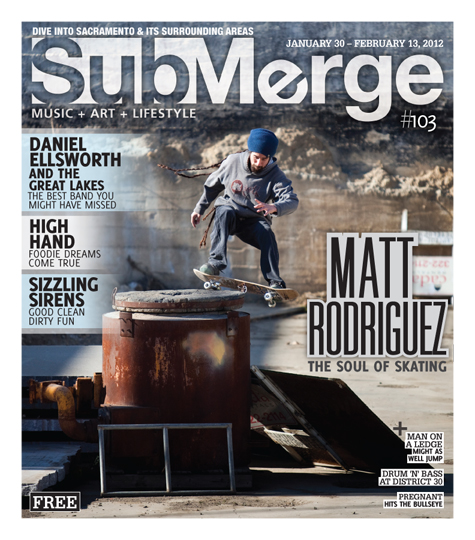
Learn more about iPath at ipath.com. Pick up The Other Ones at local skate shops or find it online by searching “iPath The Other Ones.” Learn more about Blktop Project at Galaxiarecords.com/album/blktop-project. Look for upcoming Storytellers show dates at Facebook.com/sacstorytellers and expect a new album later this year. That Rodriguez, he’s a busy dude.
Photographer Wes Davis gives skating a touch of grace in new exhibit, Step Free
Local photographer Wes Davis has captured an unusual occurrence from behind his camera lens. In the same frame, a skater is caught ollying midair as two dancers are frozen in a leap behind him, while a third dancer crouches below. In another frame a skater grinds a platform while two dancers twirl in the background, positioned as though together the three form a sequence, while another dancer holds the splits upside down beneath them. In each shot, Davis captures the ability of human bodies to fill space with motion.
These photos make up half of Davis’ contribution to Step Free, an exhibition at Beatnik Studios consisting of work by both Davis and local painter Jayme Goodwin. Goodwin’s paintings are primarily focused on dancers, while Davis’ photo collection, an array of both black and white and colored digital photos, juxtaposes the art of dancing against the art of skating. This is the first time these photos are being showcased in an exhibition.
Creating a photography exhibition that features skaters alongside dancers had been an idea floating around in Davis’ head for some time, he tells Submerge during a morning visit to Beatnik Studios.

Portrait of Davis by Mark Dillon
The half of his photos that are in color had been taken within the last one to two years, capturing his friends in their natural elements, flipping boards, ollying and grinding surfaces around Sacramento, Loomis and Portland, Ore. A longtime skater himself, the photos encapsulate an important element of his life on film.
“Pretty much anytime that you’re skating with friends, it doesn’t really matter where you are,” he says. “I really like skating the streets, just being able to push around and zigzag in and out of people, it’s kind of my favorite place to skate. But really it’s who you’re with rather than the place you’re at.”
The other half of the exhibition, the black and white photos, materialized about six months ago.
Davis found some willing members of CORE, a local dance collective, to take part in a photo shoot at Beatnik. Finding skaters for the shoot was easy, he simply had to round up some friends. The crew spent a one-day session at Beatnik and, voila, you have prints that bring skaters to the forefront of an unusual backdrop–dancers. Female dancers leaping, flying through the air, balancing on one arm, on one hand, or just posing with a smile, while a skater soars overhead, board in tow.
Davis’ shots are raw, organic, anything but contrived. The dancers are dressed in shorts and sleeveless shirts, the skaters in T-shirts and jeans. Several of the frames capture laughter, or the subtle awkwardness before someone makes their next move, it’s as though everyone was constantly in motion throughout the entire shoot.
The subjects were allowed a lot of freedom, too, Davis says.
“I like to capture people’s natural movements and their natural expressions, as opposed to portraiture, where you’re trying to create a natural look,” he explains.
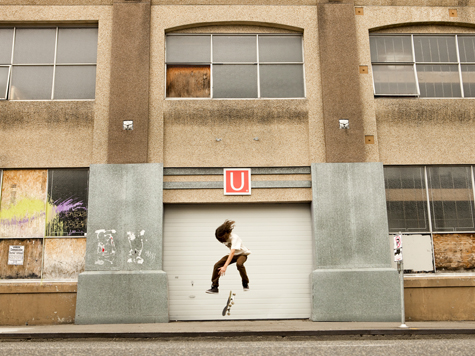
Ryan Stark, 360 Flip - Photo by Wes Davis
His requests of his subjects were minimal: dress comfortably, in whatever clothes are suited for skating or dancing on any given day. He set up a space where the skaters could perform jumps. Then the dancers were asked to fill the outside space with any movement of their choice. The result is whatever passed through the lens of his Canon 5D Mark II.
You could say that the result is a contrast of feminine versus masculine or of grace versus grit. But this stops short of Davis’ intent, which is to reveal the similarities between dancing and skating and the skill that each requires, rather than the differences.
“Dancers go through hell, they break bones, they get hurt, they’re constantly battling wounds,” Davis says. “It’s a really rugged sport, but for the spectator it’s beautiful. Skateboarders and dancers are the same people. It attracts that person that wants to be expressive and wants to be moving and use their body to develop their art.”
Of the two, dance usually gets the better rap, Davis says. Often considered a classy, highbrow art; if you are a dancer, you are considered a performing artist. Meanwhile, skating has evolved into a counter-culture here in the States, and if you are a skater, you are usually seen as the reckless punk.
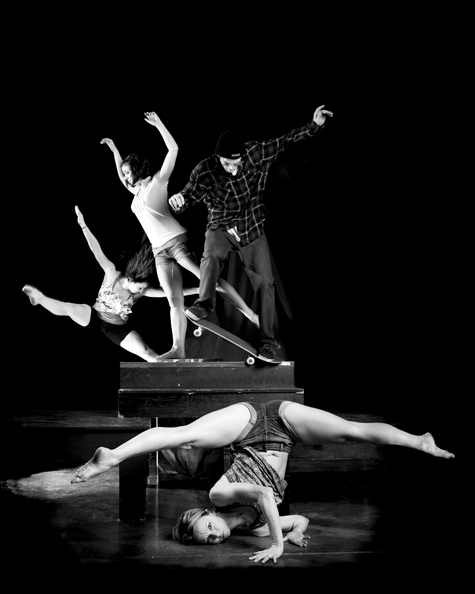
Nosegrind - Photo by Wes Davis
“You get this a lot out in the streets, people will see you on a skateboard and instantly are like, ‘Alright punks, get out of here,’” he says.
Yet, in Europe, he points out, skateboarding is the equivalent of a street performance. “People love watching it,” he says. “It’s a creative way to express yourself and think outside the box.”
The bottom line is that whether or not people choose to recognize it, both dancing and skating employ motion for artistic expression.
Davis himself picked up skating around 11 or 12, during a time when it wasn’t too common. The cool factor of skate culture wouldn’t surface for years to come. Growing up in Loomis, he was the lone skater, and in high school he would catch the nonsensical insults from jocks.
Nonetheless, his interest in skating soon segued into capturing movement on film.
“Skateboarding is what technically improved my photography [skills], because you have to learn how to shoot fast and how to really command your settings to get what you want out of it,” he explains.
Up to that point, he had been assigned the task of photographer during family vacations in the outdoors, equipped with the Pentax his father used to use while serving in the military in Germany during the ‘70s.
After graduating from Sacramento State with a photography degree he landed a gig as a soccer photographer, traveling in vans with soccer leagues regularly to shoot competitions around the country. But he quickly found himself longing for something other than being a slave to the competitions.
“I got burnt out on that pretty quick,” he remembers.
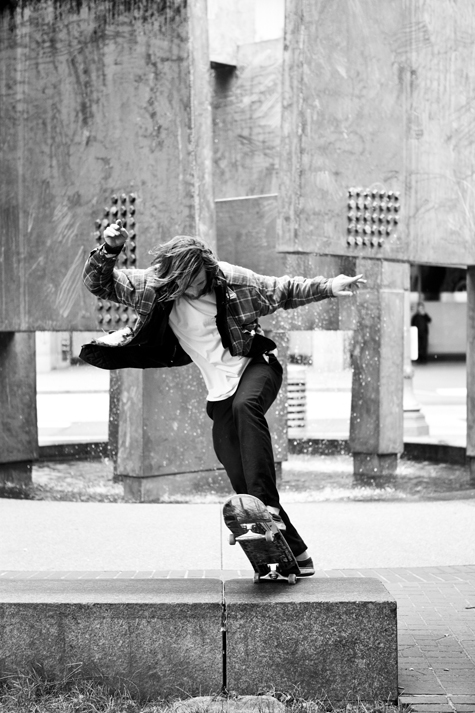
Ricky Krull, Front Blunt - Photo by Wes Davis
Though Sacramento State prepared him well in the mastery of fine art, the program did a poor job of preparing students for the business aspect, he says. For instance, he knew little about building a photography business, how to price his pieces or what the standards of the industry were. Often he was figuring out this stuff on his own, or by picking the brains of experienced commercial photographers.
Davis also realized an increasing need to hold photographers to a higher standard, where photographers are professionals, not hobbyists fiddling around with expensive cameras.
“There’s a lot of photography out there, and a lot of people that are just kind of hacks,” Davis explains. “I don’t want to insult people, but it’s true. I hear it every day, ‘Oh, I got a camera and I’m starting a photography business,’ but they’re coming to me to get coached on how to even shoot.”
In 2009, Davis quit his job working graphics at the Natural Foods Co-Op to commit himself to photography as a full-time occupation. He opened Beatnik Studios with Lindsay Calmettes, another photographer and graduate of Sacramento State, as a space for photographers to network, learn from each other and get honest feedback from others.
The two hadn’t anticipated that Beatnik would become a vital part of the local arts scene. What started as a photography space blossomed into an art gallery and event venue as well.
“It is fun [and] it is challenging,” Davis says. “It keeps us creatively motivated to restructure and reinvent ourselves.”
The space now operates as a hub for all kinds of local artists as an opportune location to express imaginative ideas, like placing dancers and skaters on the same plane.
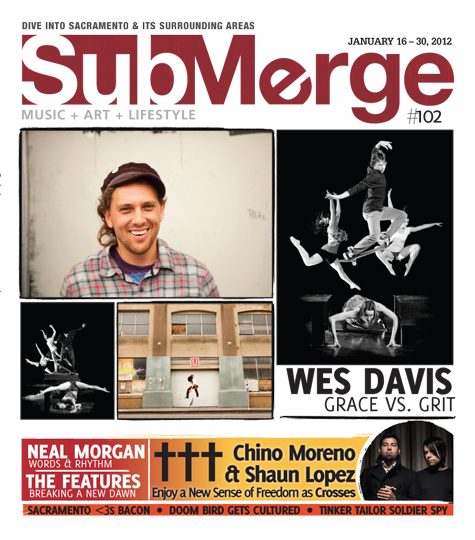
Step Free is up now through Jan. 24, 2012 at Beatnik Studios. Gallery hours are 10 a.m.—5 p.m., Tuesday—Friday. Beatnik Studios is located at 2421 17th Street in Sacramento.

Sac Hates Hip-Hop feat. Mahtie Bush” photo by Don Button, 2007
For local music scene aficionados, Bows and Arrows’ January art show, titled
Eye-Fi: A Retrospective of SN&R Sacramento Music Scene Photography, is one you will not want to miss. At the show’s opening, which is on Jan. 6 from 6 to 10 p.m., there will surely be a whole lot of, “Hey look, that’s so-and-so from such-and-such band,” and definitely a lot of, “I was at that show!” Featured photographers include Wes Davis, Amy Scott, Shoka, Jesse Vasquez, Nick Miller, Carlos Amaya, Don Button, Jon Hermison, Sean Stout, Steven Chea and more. Just some of the local artists captured by said shutterbugs are Ganglians, Appetite, Exquisite Corps, DJ Whores, Mahtie Bush, Kill the Precedent, Sea of Bees, Chase Moore, Dead Western, !!! and many more. At the opening there will be artwork for sale, as well as food, drinks and a live DJ. Bows and Arrows is located at 1815 19th Street. If you can’t make it to the reception, make sure you stop in before Feb. 2, 2012 to see the photos.
-J. Carabba
Mall walkers had reason to pause during their power walks last Sunday at the Westfield Mall. And no, it wasn’t to watch Santa Claus taking photos with crying babies or ice skaters taking falls at the rink. They paused to see the first Non-Drummer Drum-Off. The event is exactly what its name implies, people attempting to drum like Taylor Hawkins from Foo Fighters but they end up sounding like Animal from The Muppets. In fact, the only qualification of the drum-off was that you were supposed to suck. Even the Facebook event page said if someone was caught practicing before the show, then they would have been automatically disqualified.
Just like American Idol, the non-drummers had to face judges, listen to a sarcastic host and battle to win a prize. The eager non-drummers were going head-to-head for a chance to win a new drum set. At around 3 p.m., a small crowd gathered around a mini stage and bleachers on the second floor of K Street mall in Downtown Plaza that stood in-between the retail stores Express and ZuhG Life (organizers and sponsors of the event). When the show got rolling, most of the audience members ended up being random holiday shoppers, curious workers, or mall walkers who wanted to see what all of the ruckus was about.
The judges, including Matt Mingus from Dance Gavin Dance and Kevin Martinez from Tha Dirt Feeling, had to rate the non-drummers on a scale from 1 to 10 (10 being the highest) and on “charisma and performance.”
The bad drumming started off with Charleeé Wheeler from the local band ZuhG and his attempt to hit the drums like a rock star. Most of the contestants were familiar faces because they were from local bands or people who are active in the Sacramento community, such as Steph Rodriguez from Sacramento News & Review, Alexander Ayers from Prieta, a local photographer named Dennis, Michael Sean Flanagan, Dean Haakenson from Be Brave Bold Robot (who accidentally broke a drum stick while playing) and even our own Jonathan Carabba gave his shot behind the drums. After almost every performance, the host of the event (Blake Abbey from Musical Charis) would make funny, sarcastic remarks about their performance such as, “It’s so bad I want it to keep going,” or, “It wasn’t even entertaining to watch.” After Bryan Nichols, owner of the ZuhG Life store, gave his all playing the foreign instrument, Blake said, “I would rather listen to a whole Nickelback album than listen to that again.” Although the show was not exclusively awkward drumming, the audience members got to enjoy riffs from the professionals like Matt Mingus.
But the show stopper went to a small audience member who was eager to get a whack at the drums. When Blake asked if anyone from the audience would like to drum off, a young boy named Liam not only raised his hand to volunteer but stood up on the bleachers to be seen and heard. After he pulled a rampage behind the drums, he received a perfect score from the judges and huge cheers from the audience. And every time the host would mention his name he would stand on top of the bleachers and give an arm wave of victory. When he found out that he won the contest, he told his proud mom that they are going to need a “bigger truck” to carry his new gift home. Although little Liam arrived as a casual mall visitor, he left as a drumming champion.
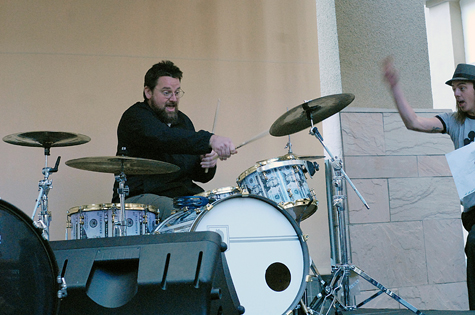
Dean Haakenson

Wes Davis
The Non-Drummer Drum Off
Westfield Downtown Plaza Mall, Sacramento – Sunday, December 4, 2011

Jesi Naomi
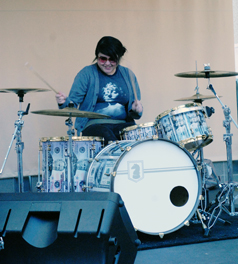
Steph Rodriguez
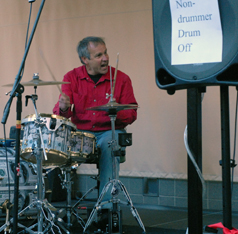
Dennis “the photographer”
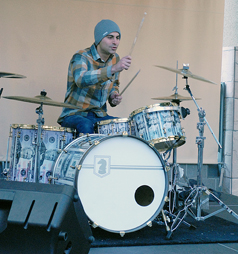
Jonathan Carabba
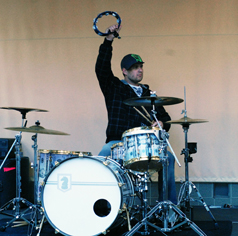
Doug Riggs

Michael Sean Flanagan
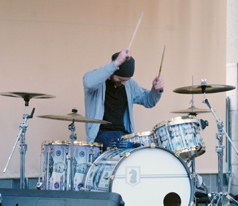
Alexander Ayers
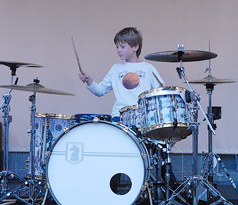
Liam
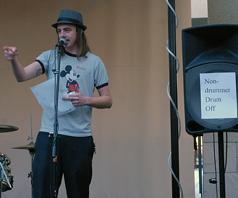
Blake Abbey
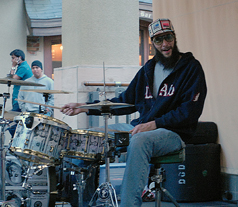
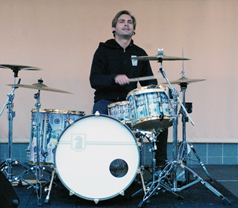
Matt Mingus
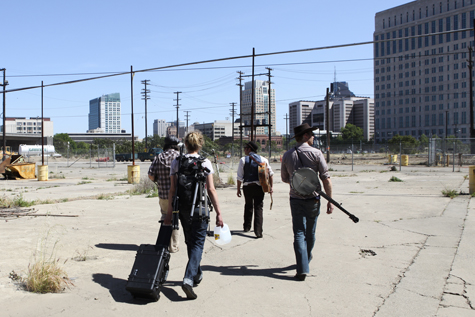
Our good friend and talented photographer Wes Davis (of Beatnik Studios) has recently started up a really cool local music video project with his good friend Devon Carsen called Live in the City of Trees. They’re partnering up with local and regional musicians, taking them to really cool spots with unique aesthetics and acoustics in and around Sacramento, and filming them perform “stripped down” versions of their songs. “Live in the City of Trees was started to be a window into the music scene in Sacramento and the surrounding area,” Davis told Submerge. “We want to film live intimate performances in unique settings and really bring an artistic and human feel to the videos. Nothing overproduced or commercial looking.” At the time we spoke, they had three videos completed and uploaded to their Vimeo page (Vimeo.com/user6451802), one with Be Brave Bold Robot shot at a “secret spot in Old Sac,” (the same secret spot Davis shot local band ZuhG for their recent Submerge cover) one with Exquisite Corps shot in the century-old Maydestone Building on the corner of 15th and J streets (said to be haunted), and one with Justin Farren shot in an old graffiti-scattered building on Q Street. A video with Blvd Park was freshly uploaded as we went to print, and Davis informed us that he also has videos with Musical Charis and James Cavern “in the can” and that those should be up shortly. He also mentioned he is shooting ZuhG soon as well as San Francisco’s Fierce Creatures after their upcoming May 27, 2011 performance at Beatnik Studios. The cinematography is stellar, the audio quality is great and the performances are fantastic–goosebump-inducing even! Whether you are a fan of the aforementioned artists or you’ve never heard of them, you’ll enjoy Live in the City of Trees. Keep an eye out for their website, Liveinthecityoftrees.com, which should be launched in the near future; but for now, just hit up their Vimeo page or find them on Facebook.
-J. Carabba
A New Album, A New Leaf
Since 2007 ZuhG has been representing Sacramento with its groove-funk style and earth-centric liberal aesthetic. They play a bit of blues, a bit of jazz and a bit of psychedelic rock. They mix hip-hop and saxophones, flutes and Rastafarian herbal idolatry. Yet, despite the multiple influences and wide range of instrumentation, ZuhG is able to sound crisp and precise. The songs on the bands upcoming CD Free Love are well produced, the bass lays in the pocket with the drums, it shifts in and out of blues guitar movements and references other standards like “Footprints.” On a musical level the group invokes a wide variety of influences, all courtesy of the guitar work of JR Halliday and Bryan Nichols, the drum work of Matt Klee, the beatbox-flow of Charlie Wheeler, and saxophone melodies from Jake Gleason. Bianca Wright holds down the luscious background vocals. All of these performers create movements that build, ebb and hit in syncopation under the optimistic experiential vocals and lyrics of Nichols.
Through multiple incarnations, ZuhG has pushed forward and with a backbone of Nichols and Klee, they’ve found a level of success, a degree of professionalism–dare we call it such–that enables the members to identify themselves firstly as musicians, secondly as anything else.
Curiously enough the group collectively (with a few friends) operates ZuhG Life, a store inside of Downtown Plaza where everything sells on consignment, and the music culture of Sacramento holds some 1,000 square feet of retail space in a largely corporate environment. Submerge was able to catch up with Nichols and discuss the upcoming album, the storefront, the popular pastime of parking-lot camping, optimism and the ever fashionable burrito windshield.
Tell me about the ZuhG Life store, how did that come about?
It’s a local music store basically. All one wall is CDs, and we’ve got local band T-shirts as well. I was booking live shows for the mall, and I needed to get paid in advance for a road trip to Oregon. When I went to get paid they brought me up to this empty store. I thought they were going to fire me, but they asked, “Hey you want to open some kind of music store?” And we just did it. The stores helped us get a lot of recognition. We’re on the news and stuff. Sometimes people think we’re called ZuhG Life, I’ve seen it on flyers. That’s funny.
Did you have any retail experience? How was that transition into owning your own shop?
I don’t really have any experience. I worked at Surf & Skate, and I hated it. I had to follow the customers around the store. The owner was all on me about it. Even when it was obvious that people just wanted to look around.
ZuhG has to be one of weirdest names I’ve ever heard for a band. How’d you decide on that?
ZuhG means to be unlike others, and to do something different. I think it’s German. I found it in a Rolling Stone ad. I turned it in for a homework assignment. I asked my teacher, after we’d been playing, “Hey I named my band that, do you think I could get that ad back?” But he said it was a really good example and he wanted to keep it. At the time I was like cool, I’ll just pick up another Rolling Stone, but I never did. I’ve never seen it since. My friend has searched countless dictionaries, and she’s never found the word.
What’s the craziest thing that’s happened to you on stage?
I caught on fire at Northstar ski resort. They always have these little propane heaters on stage. The back of my shirt caught on the little flame, and I started patting myself out when I realized I was on fire. Then JR comes over and tries to pat me down. We’re playing at the foot of this ice skating rink and everyone is watching by now. JR couldn’t put me out either, so I threw my guitar down and literally stopped-dropped-and-rolled right in the middle of the stage. It went out. The whole back of my shirt was gone. I have one little scar. It was bad at first but it healed fine.
Did you finish the set?
Yeah, we played three more songs. I think more people checked us out that day than ever.
That’s flaming! You got any other cool road stories?
We don’t ever get hotels because that would be all our gig money. Every night on the road we try to find some friends or get someone to let us sleep at their house. Sometimes we don’t get so lucky. Once in Ventura we played a shitty show, no one was there, so we just slept in the parking lot. There was this big rundown bus in the parking lot so we just pulled our cars next to it. Random [Abilideze] was with us. He was pissed that night. Six people were sleeping in the van, which is ridiculous because it only sleeps three comfortably. Dudes were sleeping in the front seat of the van. I have a little tent and I posted it up right on the concrete. Jake, our sax player, was sleeping on a cot right outside. Our roadie was sleeping in the trailer. That was fun.
You hear about bands that hate each other when they’re in the van, but when they get on stage they have amazing shows. Does that describe ZuhG, or do you get along all the time?
We bitch at each other for sure. There’s definitely some hissy fits out there. Usually whoever is pissed will just play with a ton of energy on stage that night. One time after a show in Oregon at like 3 in the morning, we stopped at a Taco Bell, and we didn’t hear our drunk bass player say he wanted a taco, so he walked out of the van. He went and sat on a curb in the parking lot. When we got up to the window we ordered him a taco and a burrito, because we forgot. I went over to our bass player. I said, “Here’s a burrito, sorry we forgot.” He grabbed the burrito and walked over to the van and threw it hella hard at the windshield. There was a whole fight in the parking lot. The Taco Bell people started calling the cops. It was hilarious. Stuff like that happens every once in a while.
Do you have any thoughts on the recent tsunami in Japan?
I was thinking of throwing a big benefit show at the ZuhG Life store to raise some money we could send over there. I want to do something to help.
Â
If you turned into a human-instrument mutant because of Japanese radiation that had made it over to Sacramento via the Pacific winds, what instrument would you prefer to be combined with?
My right arm would be a melodica, my left arm would be the neck of a guitar, my upper torso would be the body of a guitar, my right leg would be a high hat, my left leg would be a rain stick. That way if I did a handstand I could work that noise out. My head would be a djembe, and all my fingers would be kazoos! This would be a cool painting; one rad man band.
How often does ZuhG go skinny dipping together?
Ha! Never. I don’t want to see these guys naked. We do bathe in the ocean and rivers often when we’re on the road, but not naked.
Why are you such an optimist in such trying times?
In our song “New Shoes (Hippy Feet),” the hook of the first part of the song is “I’m feeling so good, I’m alive today/I’m feeling so good, and I can’t complain.” Living the ZuhG Life makes me happy, might as well be positive and peaceful. Life’s too short to be so serious. There’s no point in being pissed off all the time or pessimistic. I get stressed out every once in a while with everything that’s going on, but I love everything I’m doing, so it works out.
You sing a lot about the environment, wouldn’t it be better for the earth if ZuhG hitchhiked when you all went on the road?
Our mechanic friend, Ryan Casey, is looking for a diesel for us that we can covert to run off veggie oil. Then we’ll be green and smell like French fries all the time, but it’ll be worth it.
Theodor Adorno hated Jazz because he said the fans and musicians who thought it deviated from more traditional song structures failed to realize that it always maintained a relative steady beat, and therefore they were pretty much just hipsters–in so many words. Why do you hate jazz so much?
I love Jazz! What’s a hipster? People always say that about people but I don’t get it. Am I one?
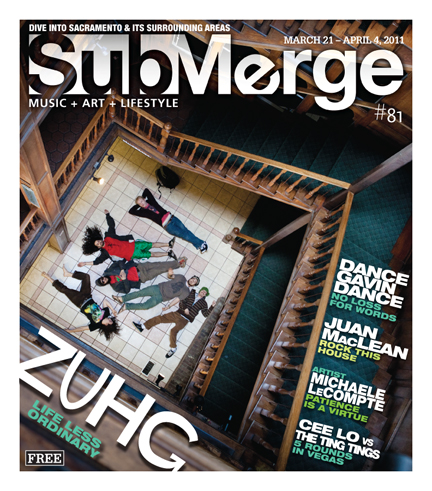
ZuhG’s CD release show will take place at Beatnick Studios on April 9, 2011. The band will also play an Earth Day show on April 13 at Sierra College in Rocklin.
Ngaio Bealum Brings the Eighth or Ninth Cannabis Comedy Festival to Sacramento
Ngaio Bealum is out to change your perception of what a stoner is supposed to be. Though the Sacramento-based comedian makes no qualms about his love affair with marijuana, his track record isn’t that of a couch-bound video game/Saturday morning cartoon junkie. Instead, you’ll find a man who is hard working and highly motivated.
“I’m not always a fan of how stoners are portrayed in the major media,” Bealum says. He believes his standup routine shows “cannabis consumers” in a different light. “I’m a pretty cool guy; I’m relatively smart, quick-witted. You know what I’m saying? I’m not dumb or unmotivated.”
If watching his act won’t change your mind, just look at his resume. Not only has he survived as a professional standup comedian for the past 20 years (he celebrates his 21st anniversary as a pro in October), he also publishes his own magazine, West Coast Cannabis, a full-color 96-page glossy, which first hit shelves in February 2008.
“It was really a ‘How hard can it be?’ sort of decision,” Bealum says of his choice to fit producing a magazine into his busy touring schedule. “But it turned out where it’s not too hard, but it was definitely a challenge at first. We’re getting it to where it flows pretty good now, but there was definitely a point or two where it was like, whoa, you know.”
In addition to that, Bealum also organizes the Cannabis Comedy Festival, which will celebrate its eighth or ninth installment (Bealum couldn’t remember which) Oct. 7 and 8 at the Punch Line in Sacramento. Bealum will host the event that boasts a lineup that includes DJ Mervin, Caitlin Gill, Keith Lowell Jensen and others. The traveling event has made stops in Portland, San Francisco and New Orleans in the past and is a fundraiser for Americans for Safe Access, an organization that helps “people who need marijuana for medical reasons have safe access to it,” says Bealum.
“I’m a big fan if you can raise money, educate and have a good time all at the same time,” he explains.
Submerge spoke with Bealum as he was preparing for a second night at Punch Line in San Francisco, after just returning from Hempstock in Portland, Ore., an event he likened to “an Oktoberfest or a wine tasting.”
“You know, all the connoisseurs get together and bring their favorite flavors, and other people bring smaller things that they had grown,” Bealum said of Hempstock and other events of its ilk, such as the Cannabis Cup. “It’s all really medical. It’s really nice.”
In the following interview, Bealum talks about his decades-long career and his favorite flavor of, well, you know”¦
Do you consider yourself a marijuana connoisseur? Do you have your favorite strain?
I’m a connoisseur for sure. I’m a big fan of sativas”¦not so much the Trainwreck, I like this new Green Ribbon that’s out right now.
What do you like most about it?
I like the kind of buzz-y head-high effects where you feel a little energized and maybe kind of chatty. I’m not so much the sit on the couch all day smoking weed stoner. That’s not for me.
If you were that kind of stoner, what would you recommend?
For that, if you’re old school, you’d go with a Romulan. But if you’re the new kids, they like the Kush or the Granddaddy Purple.
The number I’m calling you on is a Southern California number, but you’re living in Sacramento now, right?
I’ve been living in Sacramento for about a year, but it’s an open secret, so if they call me from L.A., I can still pretend. “I’ll be right there”¦in about five hours.”
What made you move up north? It seems like L.A. would be a more happening town for a comedian.
L.A.’s not really my style. I love Sacramento. It’s got a lot of civic pride, and my girlfriend lives up here, my brother lives up here, and my mom’s not too far away. She lives in San Francisco”¦ It’s got good restaurants. We rode our bikes to go to The Crocker, and then to the River Cats game. It was awesome.
Was there a final straw for you that caused you to move out of L.A.?
No, L.A. and I just get along better from a distance”¦ It’s better when I can just go down there to work and then come home.
I’ve had friends who have had prescription cards for marijuana. Do you have one as well?
I do.
A couple of friends who had cards, they didn’t really have a condition or anything. They just got their cards from doctors who were quick to give them out. I’m not saying that’s the case with you, but do you think that sort of thing hurts the cause of people fighting for marijuana legislation reform?
I quote Dennis Peron when he says, “All marijuana use is medical use.” Now, some people may not take it to that extreme, but if you derive some therapeutic value from feeling better”¦ Studies say that if you take a shot or two or have a glass of wine after dinner, you may actually get some benefit from it, so who’s to say that people who enjoy a toke or two aren’t getting some benefit from it. It’s a natural anti-inflammatory and mood leavener, so who doesn’t like to smooth out and feel less pain?
Do you foresee a day when marijuana is just legal across the board?
Yeah, I don’t think that’s too far in the future, actually. It’s getting there. We’re starting to reach the tipping point.
You’ve been doing this for 21 years now”¦
Yeah, 20 years. October will be my 21st anniversary as a professional comedian. Where’s my watch and retirement plan?
Is there a good pension for comics?
Yeah, it’s called shitty one-nighters. You can do those till you’re 80—have your kids drive you. “C’mon, we’ve gotta get to Missoula. Hurry!”
Does it bother you to be labeled as a weed comedian?
No. As I’ve said, I’ve made a pretty good career out of it. You know, it’s funny, because I did a show at the Punch Line last night, and it wasn’t even a stoner crowd, which was funny to me. It took me by surprise at first, because I didn’t really go for a lot of the marijuana jokes, so fortunately, I have a whole other act that consists of jokes about my kids and quantum physics and psychedelic poetry.
In the years you’ve been a professional comedian, how have you seen the scene change?
I started comedy in 1988, which was sort of the ass-end of the comedy boom. Comedy was just starting to take off, there were a lot of clubs and there weren’t really that many comics, so there was a lot of work everywhere. It was really comedy-based. If you were really funny, you’d get a lot of work. It didn’t matter if you were on TV or not. When I started, you had to do a lot of roadwork in clubs to get on TV, and now, you have to get on TV to get into the clubs. I also think that comedy is changing its model, because more and more corporations have gotten involved. You know, Viacom owns Comedy Central, so comedy has become a commodity and not just a visceral way to entertain people. But with the advent of the Internet, I think the underground scene is coming back again, and the do-it-yourself punk rock vibe where all you really need is a room and a microphone and 50 people who can pay $5. You can make some money and get your point across without worrying about what you can and cannot say and how you will be perceived on television.
See the Cannabis Comedy Festival on Oct. 7 and 8 at the Punch Line in Sacramento. The show is 18 and over and carries a two-drink minimum. For more information on Americans for Safe Access, go to www.safeaccessnow.org
